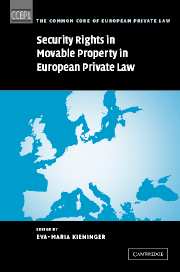Book contents
- Frontmatter
- Contents
- General editors' preface
- Preface
- List of contributors
- Table of cases cited by name
- Table of legislation
- Part I Introduction and context
- List of abbreviations
- 1 Introduction: security rights in movable property within the common market and the approach of the study
- 2 A labyrinth of creditors: a short introduction to the history of security interests in goods
- 3 Security in movables in the United States – Uniform Commercial Code Article 9: a basis for comparison
- 4 The English law of security: creditor-friendly but unreformed
- 5 The European Bank for Reconstruction and Development's Secured Transactions Project: a model law and ten core principles for a modern secured transactions law in countries of Central and Eastern Europe (and elsewhere!)
- Part II The case studies
- Index by country
- Index by subject
5 - The European Bank for Reconstruction and Development's Secured Transactions Project: a model law and ten core principles for a modern secured transactions law in countries of Central and Eastern Europe (and elsewhere!)
Published online by Cambridge University Press: 23 December 2009
- Frontmatter
- Contents
- General editors' preface
- Preface
- List of contributors
- Table of cases cited by name
- Table of legislation
- Part I Introduction and context
- List of abbreviations
- 1 Introduction: security rights in movable property within the common market and the approach of the study
- 2 A labyrinth of creditors: a short introduction to the history of security interests in goods
- 3 Security in movables in the United States – Uniform Commercial Code Article 9: a basis for comparison
- 4 The English law of security: creditor-friendly but unreformed
- 5 The European Bank for Reconstruction and Development's Secured Transactions Project: a model law and ten core principles for a modern secured transactions law in countries of Central and Eastern Europe (and elsewhere!)
- Part II The case studies
- Index by country
- Index by subject
Summary
Introduction
It is noteworthy that the Project on the Common Core of European Private Law has chosen, among the many subjects it endeavours to cover, the question of security over movable property. Indeed, movable property may be a subject that is neglected during the years of studying law at university, especially it seems in the UK where it falls somewhere between the courses on land law and commercial law. However, in practice, movable property is of the utmost importance; this is particularly visible in the realm of credit where the diversity and versatility of movable property will make it of prime appeal to creditors as a means of guaranteeing their claims. Moreover, since transactions involving movables are far more numerous, this multiplies further the number of occasions when elaborate legal constructions over these assets can be imagined. The fifteen cases drawn as part of the questionnaire for this volume give a good, if small, sample.
In economies in transition such as the economies of Central and Eastern Europe and the former Soviet Union Republics – now the Commonwealth of Independent States – movable property as a tool to enhance credit facilities and conditions is a new concept. To some extent, secured credit is also a new concept. Until the 1990s, there was hardly any legal provision allowing movable property to be used to guarantee a loan without losing the ability to use the assets. Basically, the possessory pledge, often referred to as a pawn, was the only means available.
- Type
- Chapter
- Information
- Security Rights in Movable Property in European Private Law , pp. 98 - 114Publisher: Cambridge University PressPrint publication year: 2004
- 3
- Cited by

